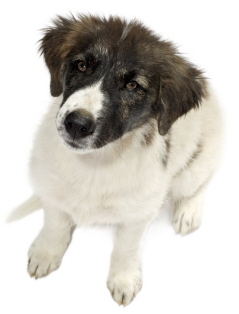
A
good start to teaching your
dog manners is to consider
using the "sit" instruction
for when you want your dog
to say,
"Please" for things
he or she wants.
Because we
love our dogs, there is a natural tendency to pamper
them. We think it's cute when they show us what they
want and so we respond by giving it to them. Many
dogs misinterpret this loving generosity as
subordination and get the wrong message that they
are leaders in the relationship. This
leads to trouble.
When you teach your
dog to automatically say
please by sitting, you dog
will learn to ask for
permission rather than
forgiveness after acting
inappropriately. Once your
dog consistently sits
automatically in the
situations described, you
can elect to phase it out of
your normal routine. However
we recommend you
periodically remind your dog
through out life.
|
Your dog will respond more
to your actions than to your
words. Make sure your body
language and actions are
correct. |
We
recommend you practice these
exercises until your dog will
consistently say "please"
without you having to cue a sit.
Then each time your dog wants
something from you all you have
to do is wait for him to say
"please"!
Where to begin?
Start in a small room prior to a
meal. If your dog gets bored and
walks off before sitting place
your dog on a leash tied to your
waist
(umbilical tether). Make sure your dog sees
you have a treat or meal so that
it is apparent what will be
earned. Now hold the treat
in your closed hand keeping it
still and waist high. Your dog
will likely be a little confused
and may try to get your
attention by jumping, pawing or
barking at you. Be still and
quiet and ignore all attempts
made to get your attention. You
may turn your back.
Your dog may get frustrated and
give up, looking for something
more fun to do. But since your
dog is in a small room with you
or tied to you if he's hungry
enough you can just wait him out
and he'll eventually sit.
Immediately offer the treat
before your dog has a chance to
get up.
Now take a few steps backward
hiding another treat in your
hand and repeat the above
exercise.
After 10
successful repetitions repeat
the exercise while hiding the
treat in your hand. If your dog
wanders you may use your
umbilical tether or may attempt
a smooching sound. We don't want
to teach your pet to ignore
their name so do not use their
name unless you are 100% certain
they will look at you
immediately. If smooching
doesn't get your dogs attention
just be quiet and patient until
boredom sets in which results in
a sit. When this sit results in
a treat appearing you will not
have to wait as long the next
time!
Each time you start this
exercise your dog is likely to
start in with the same begging
or unruly behavior as before.
When this routine causes your
pet to become invisible due to
this behavior they will try what
worked last time, SITTING!
You just have to be ready to
deliver that treat quickly when
you get the correct response
before your pet has a chance to
stand up.
Now, practice this exercise 10
times with a hidden treat with
no umbilical tether, and then in
various places in the house. By
the end of these exercises your
dog should know if he offers a
sit to "say please" it will
result in a reward. When
your pet successfully says
please 9 out of 10 times in
various places in the house
begin to alternate treats and
verbal praise or petting.
Remember not to use a verbal cue
to "sit" because we do not want
to micro-manage the sit.
We want then to "say please"
automatically each time they
want something from you! Now you
should begin to request you pet
stay seated until you have
acknowledged his request. For
instance, when your pet sits for
you to open the door, do not
reward the sit. Begin to open
the door. If your dog stands,
close the door. Repeat this
exercise until your dog will
stay seated with the door wide
open until you give a treat and
say it is ok to go through. You
are teaching a second important
lesson here. The door only opens
when you are sitting!
Below are the places are that we
suggest you wait for your pet to
"say please".
-
To receive meals or
treats
-
To go through doorways and
gates, especially when
guests come to the door
-
To greet people
-
To
get come
out of the kennel
-
To
play
fetch or tug-o-war
-
To
be
invited up on the
furniture or bed
-
To get
a leash on
to go
for a walk
-
To get
in or
out
of the car
If you are not getting quick
sits and do not see a
dramatic change within a few
days evaluate the following
items to determine what may
be going wrong.
-
Is your timing off?
Do you give the treat
before your pet stands
up?
-
Are you and the family
consistent? Do you
require a sit to earn
some privileges but not
others?
-
If your dog never sits,
are you waiting long
enough? It may
take several minutes at
first.
-
Are you standing still
or moving around while
waiting for the sit?
Remember to be still
like a statue.
-
Is your dog motivated by
the treat? For instance
if your pet has no
desire to go outside
requesting your pet to
say please to go out
will not work.
-
If your dog is jumping
give multiple treats
while they are sitting.